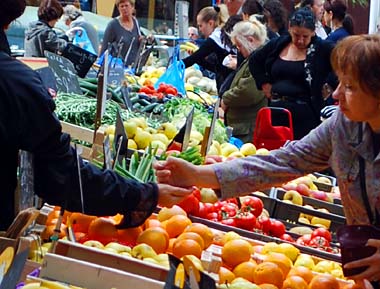
Money exchanges hands over a purchase in the marketplace
at Carcassonne: the essence of a market, medieval or modern.
Photo © S. Alsford
The provisions market, if no longer the pre-eminent source of foodstuffs for many households, remains an institution that has survived in some form in most towns and cities; in some places held daily, elsewhere just once a week, it still attracts strong custom. In its fundamentals the modern market is much like its medieval predecessor. While fairs have transformed from manifestations of commerce into recreational expressions of that heritage, markets remain essentially events for buying and selling. There can still be found examples representing the different phases of development of markets, in terms of the permanency of trading stations. As well, some markets today deal only in foodstuffs, others are a mix of victuals and non-food products, while a few are specialized (a notable example being the Petticoat Lane market in London, an extraordinary collection of over a thousand stalls selling clothing, spreading out from its principal street location into several adjacent streets.
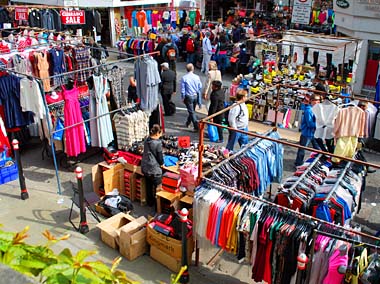
One small part of the Petticoat Lane market.
Photo © S. Alsford
Some modern provisions markets held in the open air tend to limit themselves mainly to fruit and vegetables, but the larger ones and those better protected from the elements and scavengers, are more wide-ranging, with vendors selling meat, fish, bread, cheeses, spices, preserves, and various other foodstuffs, as well as clothing, dress accessories, housewares, furnishings, and portable goods of all sorts. The wider-ranging kind appears more typical of medieval markets; although provisions may have predominated, local artisans, who spent most of their time in their workshops, must have seen the main market day as an opportunity to bring their products to wider attention. Most towns, even smaller ones, seem to have had at least the most important industries – producing milled, baked, brewed, and butchered consumables as well as essential goods in leather, cloth, wood, and iron – represented by at least one or two artisans, whose output met most local needs. Sales of large livestock, on the other hand, seem to have been segregated from the main marketplaces of most English towns well before the Middle Ages came to a close.
Market goods can still be seen displayed to consumers in a variety of ways: on cloths laid out on the ground, in bags, boxes, and baskets, hung from racks, but above all spread out across stalls. Much the same might be said of medieval markets.
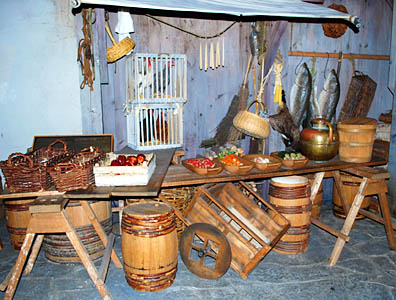
Photo © S. Alsford
(above) This exhibit in the Canadian Museum of Civilization,
representing a market component of its New France town square reconstruction, is a condensed
amalgam aimed at showing the various types of goods available in the market. We see,
beneath an awning, a trestle table stall, under which sits a hand-cart used by vendors
to transport their goods to market. Upon the table are baskets containing bread,
a box of apples, cages holding chickens, trays of vegetables and eggs, and a pitcher
of milk. Below, barrels of beer, and at rear hang candles, ropes, brooms, corn,
and fish, while firewood is stacked on the ground.
(below) The museum exhibit is reminiscent of market scenes by the Flemish painter
Joachim Beuckelaer (1533–1574) who, continuing in a style set by his artist uncle
Pieter Aertsen (1508-75), with whom he trained, aims to show the rich variety of foodstuffs
available – here in his depiction of one female market vendor (1564) we see an improbable
overabundance of baskets and other containers of fruit and vegetables, while she also has
poultry to offer.
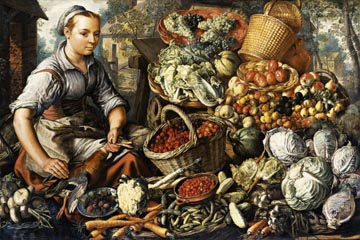
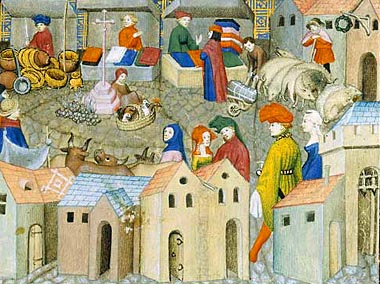
Bibliothèque nationale de France, département des Manuscrits
The same kind of approach – a synthesis of commercial iconography
rather than documentary representation – can be seen in this depiction of a marketplace
of an imaginary town, in an early fifteenth century French manuscript, Le Chevalier
errant. The artist's intent here is to show characteristic features of a market:
buyers and sellers, cloth traded from formal stalls, produce sold from baskets on the ground,
onions and poultry offered by a country-woman stationed by the market cross, livestock
on the peripheries; note also the lanes leading through surrounding residential areas
into the marketplace, the city gate where tolls would be collected, the tavern on one side
of the marketplace, the lame beggar positioned strategically outside it, the porter
with wheelbarrow, and a prostitute talking with a potential client near the houses.
Temporary stalls – set up where markets were held only once or twice a week, or brought in by rural farmers who had carts – were much like medieval domestic tables, formed from one or more boards (the table proper) supported at either end by trestles; the most common type of trestle, judging from medieval illustrations, had three legs. Dismantleable stalls similar to these are can still be found at flea markets, and even some provisions markets, today. Some medieval stalls, however, perhaps particularly those put up at fairs, involved more installation work and owners could expect to be charged a fee for picage (breaking the ground with a pick-axe), so that support posts could be sunk. No wonder, then, that petty traders reduced their costs by making do without stalls, preferring to sell from carts, packhorses, or, more often, baskets carried to market on their backs. This did not guarantee they would be free of some fee for taking up space in the marketplace; the owner of the Hartlepool market in the late fourteenth century, for instance, charged a halfpenny per site where a packhorse was 'parked'.
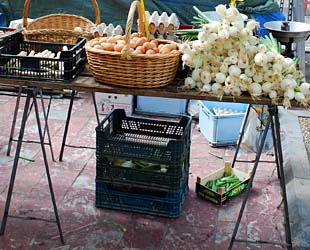
Today market vendors may still use equipment and display methods
largely unchanged from those of medieval counterparts, as at (above) the Place Carnot market
in Carcassonne, where one stall, of the trestle table type, holds a basket of eggs and
a pile of onions, and another (below) shows spices in small sacks, with weighing machine
at rear.
Photos © S. Alsford
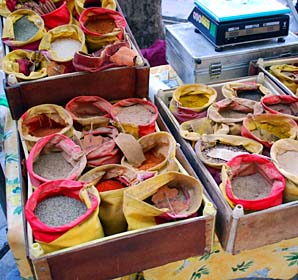
Compare the present-day stall above with the medieval depiction
below of Berthold Uslaub, a Nuremberg spicer who died in 1453. He is shown at his stall,
fashioned from a board placed atop a barrel, set up in the street, with spice-filled bags
spread out over the board; with a small hand-held pair of scales he weighs a quantity
of the spice taken from the bag on which his other hand rests.
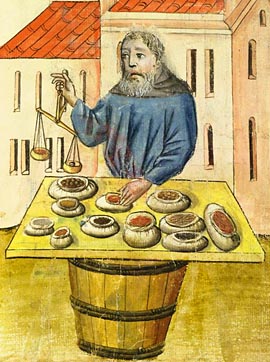
From the Hausbuch der Mendelschen Zwölfbrüderstiftung
It is not hard to imagine how some stalls may gradually have become fixtures on rented spots, particularly where markets were situated in dedicated spaces (as opposed to along main streets) and there was no pressure to dismantle and remove them between market days. Some stall-holders, if they did not have shops elsewhere, may have manned their stalls on days other than the full market day. Such stalls could be more sturdily constructed and lent themselves to protective roofs and/or side-coverings. A desire not to have to remove merchandize daily would have prompted enclosure of stalls with strong materials. These stalls were on their way to transforming into shops.
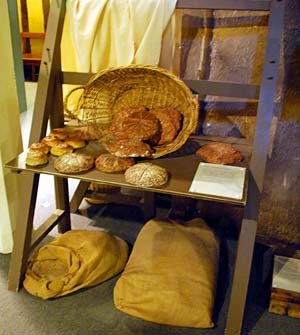
(above) Reconstruction in Colchester Castle Museum of a market stall
where bread (from a basket) and grain (in sacks) are for sale; this represents a sturdier
kind of stall structure, to which a canvas covering could offer rain protection. It seems
to be based on a market scene drawn by Jan de Tavernier for the Chroniques et Conquetes
de Charlemagne, where shown with an awning installed.
(below) This scene from a modern farmers' market in Ottawa exemplifies dismantleable
stalls with roof covering. This is more in the style of booths erected at fairs.
Photos © S. Alsford
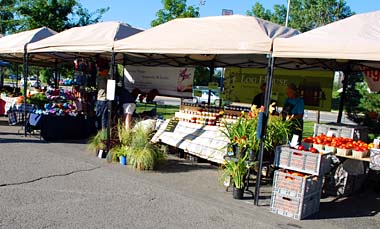
In the Middle Ages, as still today, some markets could be more informal or impromptu, dictated by point of entry of goods. A modern counterpart might be a small fish-market on the quayside at Viareggio (a Tuscan coastal town), held where fishing-boats land their morning's catch; however, these stalls have to obtain a licence from the comune to operate daily.
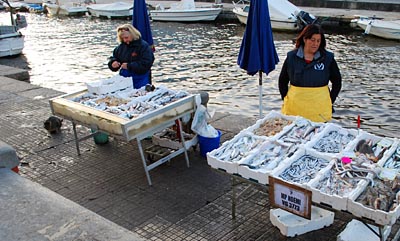
The small fishmarket at Viareggio. The vendors appear to be
the wives of the fishermen. The latter, having unloaded their early morning catch,
have headed back out to sea.
Photo © S. Alsford